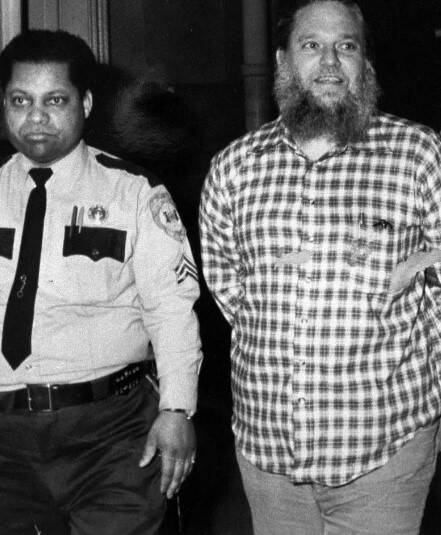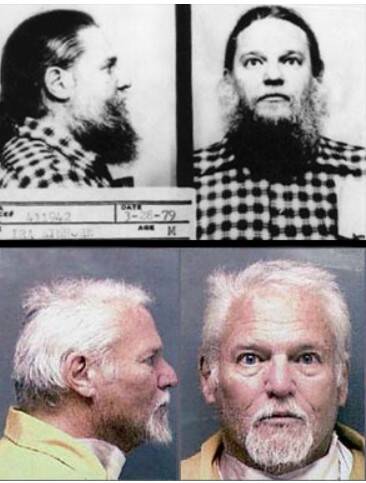Ira Einhorn was one of the most iconic counterculture figures of Philadelphia — until he killed his girlfriend Holly Maddux in 1977 and went on the run for nearly two decades.

Temple University LibrariesIra Einhorn addresses a crowd as the Master of Ceremonies for the first-ever Earth Day in 1970.
In the 1970s, hippie guru Ira Einhorn was known in his hometown of Philadelphia as one of the loudest voices in the countercultural and environmental movements of the day. In fact, he often boasted that he co-founded Earth Day in 1970, though the event’s organizers later refuted this claim.
But although Einhorn appeared to be a peace-loving hippie, it soon became clear that that persona was masking something much darker. In 1977, Ira Einhorn murdered his ex-girlfriend Holly Maddux — and then “composted” her body in a trunk alongside Styrofoam, air fresheners, and newspapers.
When Maddux’s body was eventually discovered, Einhorn was arrested, but he managed to escape to Europe, dodging capture for almost 20 years in a cat-and-mouse game with the authorities before he finally faced justice.
This is the story of Ira Einhorn, the environmental activist who became known as the “Unicorn Killer.”
Ira Einhorn, Philadelphia’s ‘Number One Freak’
Born on May 15, 1940, Ira Samuel Einhorn grew up in a middle-class Jewish family in Pennsylvania. He graduated from the University of Pennsylvania in 1961 with a major in English and went on to pursue an academic career.
From 1964-1965, Einhorn worked as an instructor of English at Temple University. However, it’s possible that Einhorn’s frank conversations with his students about cannabis and LSD didn’t endear him to the university’s administrators, because Temple did not renew his contract.
Around that time, Einhorn was also making a name for himself as an activist. A charismatic speaker, he gradually became a prominent radical voice in the anti-establishment, anti-war, and anti-violence movements of the era, charming many of Philadelphia’s elite along the way and creating a cult of personality around himself.

YouTubeIra Einhorn, the Unicorn Killer.
He was also no stranger to drugs, and launched a rescue service for people experiencing bad trips and taught a series of free courses around the LSD experience.
According to The New York Times, the Village Voice called Einhorn “indisputably Philadelphia’s head hippie” and the city’s “number one freak.” But the nickname that stuck was the one he gave himself: “Unicorn,” which he chose because his German surname roughly translated to “one horn.”
Did He Really Found Earth Day?
With his long hair and beard, Ira Einhorn seemed to embrace his reputation as a hippie guru, and he touted himself as an environmental activist, embedding himself in Philly’s prominent ecological groups.
Einhorn even claimed to have founded Earth Day. But most sources credit Gaylord Nelson, a Wisconsin Senator at the time, as the one who started the holiday by suggesting that all Americans set aside April 22 as a day to discuss environmental issues.
Einhorn was involved in the first-ever Earth Day rally in Philadelphia, and a photo of Einhorn on stage at the event in 1970 identifies him as its “Master of Ceremonies.”
But according to Philly Mag, he had no role in actually organizing the event. In fact, the rally’s organizers said Einhorn disrupted meetings and alienated everyone involved — and on the day of the event, all he did was hog the podium for 30 minutes and refuse to get off the stage after his speech.
Becoming The Unicorn Killer
Boasting a monumental ego, Ira Einhorn was domineering with women and sometimes became violent if they rejected him. TIME reports that two of his former girlfriends ended up in the hospital after they tried to break up with him — one of whom he’d hit over the head with a Coke bottle, and one of whom he strangled.
In 1972, Einhorn met Helen “Holly” Maddux, a recent Bryn Mawr College graduate from Tyler, Texas. Just days after they met, Maddux moved into Einhorn’s apartment, and the two began a tumultuous five-year relationship.
Maddux was a bright, elegant young woman who her sister described as having “the same kind of fragile beauty” as Michelle Pfeiffer. She quickly got swept up in Einhorn’s charisma, but it wasn’t long before the relationship soured.
Maddux’s family never liked Einhorn, finding him to be rude and overbearing, and they sensed that he was bullying Maddux — and eventually, she became fed up with him, too.
Sometime in early autumn 1977, Maddux broke up with Einhorn and moved to New York. Einhorn did not take the news well. He called her in a rage, threatening to throw her personal belongings onto the street if she didn’t come back to the apartment to pick them up.
On September 9, 1977, Maddux returned to Einhorn’s Philadelphia apartment to collect her things. She was never seen alive again.
When the Philadelphia police questioned Einhorn about Maddux’s mysterious disappearance, he simply claimed that she had gone out to the neighborhood co-op to buy some tofu and sprouts, and never came back.
The Maddux family, frustrated over the lack of progress in the investigation, hired a private detective — and within months, he uncovered the shocking evidence that would expose Ira Einhorn as a murderer.
The Discovery Of Holly Maddux’s Body
Suspicious of Maddux’s ex-boyfriend, the private detective spoke to a student who lived in the apartment below Einhorn’s. The student recalled that one night in the fall of 1977, he had heard a “blood-curdling scream,” accompanied by loud bangs.
As time passed, the student also observed a reddish-brown, foul-smelling liquid dripping down from the ceiling directly below Einhorn’s apartment. When the landlord called plumbers to fix the leak, Einhorn had refused to let them in to investigate the place the dripping was coming from: a padlocked closet near Einhorn’s bedroom.

Temple University LibrariesIra Einhorn under arrest for Holly Maddux’s murder.
The private investigator passed this information on to the police, and finally, on March 28, 1979, homicide detectives pried open Einhorn’s padlocked closet and were met with a putrid smell — and found Maddux’s partially mummified body stuffed into a trunk. Packed in alongside her decomposing corpse was a strange assortment of items: styrofoam, air fresheners, and newspapers.
Later, it was found that Maddux had been bludgeoned to death, her skull fractured in at least six spots.
Einhorn was arrested for Maddux’s murder, but he maintained his innocence. Using his signature charm, he convinced Barbara Bronfman, a wealthy Montreal socialite Einhorn had met through a shared interest in the paranormal, to pay his bail. He also announced to his many followers that Maddux had been murdered by the CIA as a government setup because Einhorn knew too much about their paranormal research.
And in 1981, just days before his murder trial was set to begin, Einhorn jumped bail and fled to Europe, where he successfully evaded capture for 17 years.
Ira Einhorn’s Life On The Run
Under the aliases Ben Moore and Eugene Mallon, Einhorn hid out in Ireland, the United Kingdom, and Sweden. Meanwhile, investigators interrogated Einhorn’s friends in the U.S. about his whereabouts. Finally, they made a breakthrough.
For years Barbara Bronfman had financially supported Einhorn as he traveled through Europe. Then, in 1988, she read Steven Levy’s damning book about Einhorn, The Unicorn’s Secret. Disillusioned with the hippie guru, she promptly gave the Philadelphia District Attorney’s office the name of a wealthy Swedish woman: Annika Flodin.
When investigators tracked Flodin down, she claimed to be Einhorn’s landlady and nothing more, but investigators sensed that Einhorn had slipped away again, one step ahead of them. Soon, Flodin had slipped away too, suddenly abandoning her home and fleeing, making it impossible for investigators to reach her for further interrogation.

Wikimedia CommonsIra Einhorn’s 1979 and 2001 mug shots.
Meanwhile, back in the United States, Einhorn was convicted in absentia for Maddux’s murder in a 1993 trial and sentenced to life in prison.
Then in 1997, a Stockholm police contact managed to obtain Flodin’s social security number, and after running her name through motor vehicle records in Sweden learned that she had applied for a French driver’s license in 1994. Notably, she had applied under the name Annika Flodin Mallon.
In 1997, authorities traced the address Flodin had listed and arrived at a converted windmill in Champagne-Mouton, France. There, they found Ira Einhorn. They soon learned he and Flodin had married, and that he’d been living in France under the alias Eugene Mallon.
After 17 years, Einhorn was finally arrested. But because of the complex extradition laws between France and the United States, it was another several years before he was returned to the U.S. In the meantime, Einhorn relied on multiple legal avenues to slow down his extradition process while he continued to live somewhat freely in France, albeit under surveillance by the French police.
How The Unicorn Killer Finally Faced Justice
In July 2001, the Council of State, France’s highest administrative body, announced an order that Ira Einhorn be extradited to the United States. France had agreed to return him on the grounds that Einhorn would be granted the chance to another trial, this time with Einhorn present.
Finally, it seemed Einhorn would face justice. But after hearing the news, Einhorn, who was at home, cut his throat with a knife, slightly delaying his departure even further.
However, the wound seemed more of a delaying tactic than a genuine attempt to take his own life, as Einhorn promptly invited a French television crew into his home for an interview, which he gave with blood still dripping down his front. Only after the interview was over was he taken to a hospital.

STAN HONDA/AFP via Getty ImagesIra Einhorn is escorted in handcuffs out of a plane early in July 2001 after being extradited back to the United States.
After 23 years abroad, Einhorn was finally extradited to the United States — and 25 years after the murder of Holly Maddux, he finally stood trial.
Taking the stand in his own defense, Einhorn again touted his claim that the murder had been a government setup, and also told jurors he had a “Virgo moon.” The jury took all of two hours to find him guilty.
On Oct. 17, 2002, Einhorn was once again convicted of the murder of Holly Maddux, and the following day he was sentenced to life in prison without parole. Philadelphia’s district attorney Lynne Abraham summarized his conviction perfectly:
“Metaphorically speaking, Ira Einhorn and his Virgo moon are toast.”
Abraham was right. On April 3, 2020, Einhorn died in prison of natural causes at the age of 79.
After learning about “Unicorn Killer” Ira Einhorn, read about serial killer Joe Michael Ervin, whose crimes were exposed using DNA technology 40 years later. Then, learn about Drew Peterson, the Chicago cop who killed his third wife and left her in the bathtub — and whose fourth wife went missing.





